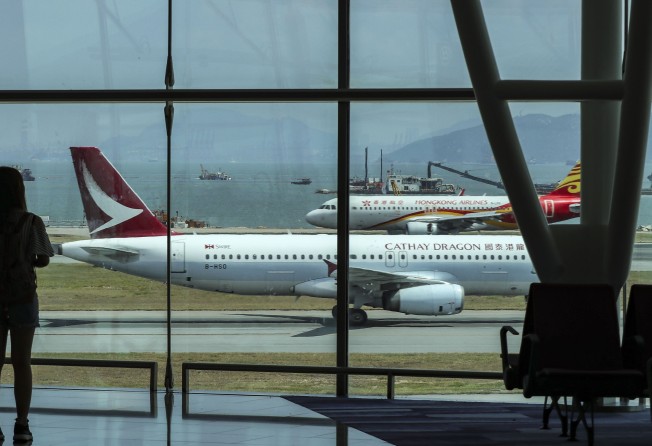A Hong Kong airport fourth runway may be good for business, but it would be terrible for the environment
Paul Stapleton says the discussion surrounding a fourth runway for the city’s airport has ignored the high carbon footprint of air transport

“If you build it, they will come.” That was the line quoted by Kevin Costner’s character in the 1989 movie, Field of Dreams. The sentence has now entered the popular vernacular to roughly mean, if you build something, it can create its own demand.
And, although everyone knows this message doesn’t always pan out, which is why we have the term “white elephant”, it most certainly does apply in the case of the recent discussion about Hong Kong International Airport’s potential fourth runway.
This talk of a fourth runway is now starting to appear in the news before landfill from the third runway has even emerged above sea level. But the fact that the fourth runway has entered the discussion, although mostly to cast doubt on its need, is a telling statement of our times. Economic growth will always triumph over planetary health.
This casting of doubt on the need for a fourth runway actually requires some doubt cast upon itself. The move of Hong Kong’s airport from Kai Tak 20 years ago was expressly because that locale, with its one runway, had reached its capacity. At the time, Chek Lap Kok’s two new runways were viewed as more than sufficient. Twenty years later, both runways have now reached capacity, thus the need for yet another one.
Clearly, we are witnessing a pattern here: when runways reach their capacity, build a new one.
Further, world air traffic is projected to nearly double between now and 2036, growing from 4 billion to close to 8 billion passengers. And, given that this increase will be most intense in the Asia-Pacific region, a fourth runway, despite the scepticism, is all but inevitable.
A simple look at the numbers tells the story. Presently, our two runways at their full capacity handle 68 flights per hour. However, apparently, there is already demand for 93 flights. Although the third runway will increase flights per hour from the present 68 to 104, by the time it opens in 2024 or soon thereafter, the demand is likely to easily reach the saturation point of the three runways.
With each wide-body aircraft carrying well over 100,000 litres of fuel, the exhaust gas from these extra flights emitted into our atmosphere is staggering
Hong Kong is not alone in reaching runway capacity. British MPs have just approved construction of a third runway at London’s Heathrow airport even though London already has two other international airports. Although the approval came with an overwhelming majority, construction will not begin soon because of the many legal hurdles put in place by opponents. Their concerns range from noise to kerosene exhaust gases and climate change.
Back here in Hong Kong, the biggest concern about the third runway is how much it will cost and who will pay. And although environmental concerns such as noise pollution and threats to the local dolphin population are often mentioned, virtually nothing has been said about climate change.
To understand the impact an extra runway will have on atmospheric conditions and global warming, let’s revisit those numbers about flights per hour increasing from 68 to 104 with the third runway, that is, 36 extra flights per hour.
Assuming a conservative operating schedule of 20 hours a day, this would mean 720 extra flights each day, or over 250,000 extra flights per year. With each wide-body aircraft carrying well over 100,000 litres of fuel, the exhaust gas from these extra flights emitted into our atmosphere is staggering.

The concept of a carbon footprint has recently become used as a measure of the amount of carbon dioxide released into the atmosphere as a result of the activities of a particular individual. Flying is considered to have a singularly large carbon footprint because of the amount of fuel it takes to lug a heavy aircraft 10km into the sky and keep it moving fast at that level for hours on end.
Carbon footprint calculators reveal that a return trip from Hong Kong to London in business class generates a footprint of up to 7 tonnes of carbon, which is roughly equivalent to the total annual footprint of the average Hong Kong resident. Even flying economy on the same routing would use up close to half a year’s worth of an average resident here.
Added to this is the fact that emissions from commercial aircraft, which are mostly released in the stratosphere, have a considerably greater damaging effect on the environment than at low altitudes. Some estimates claim a multiplier effect of at least two and possibly up to four times should be applied to aircraft emissions in terms of their negative impact on climate change.
Although the damage to our atmosphere caused by commercial aircraft is well established, somehow climate change is not even part of the discussion around the third, or possibly fourth runway. Rather, the biggest concern is how much more passengers will pay for tickets to offset the cost of the new runway.
The “if you build it, they will come” mentality has served humanity well over the centuries. The Colosseum, pyramids and Eiffel Tower come to mind. But when new mega projects like our third runway are built simply to facilitate economic growth, we are completely ignoring the big, long-term picture, which is the health of our planet.
Ironically, projects like the third runway may in fact be contributors to their own demise. In a century or two, they could well be under water.
Paul Stapleton is an associate professor at the Education University of Hong Kong